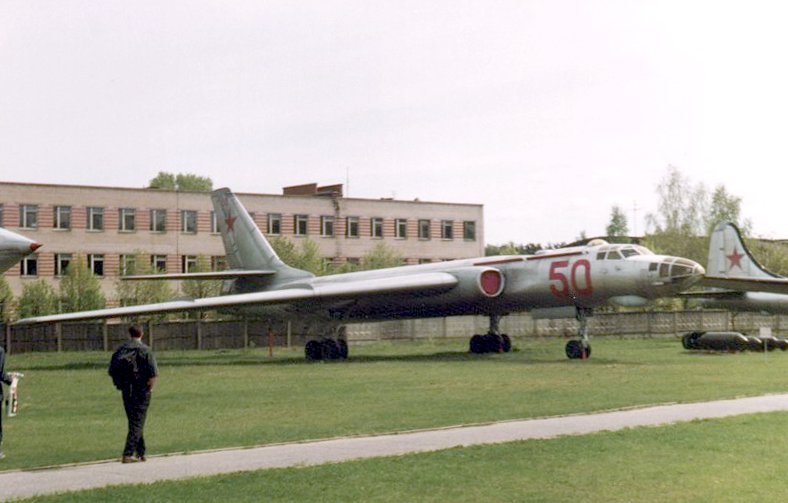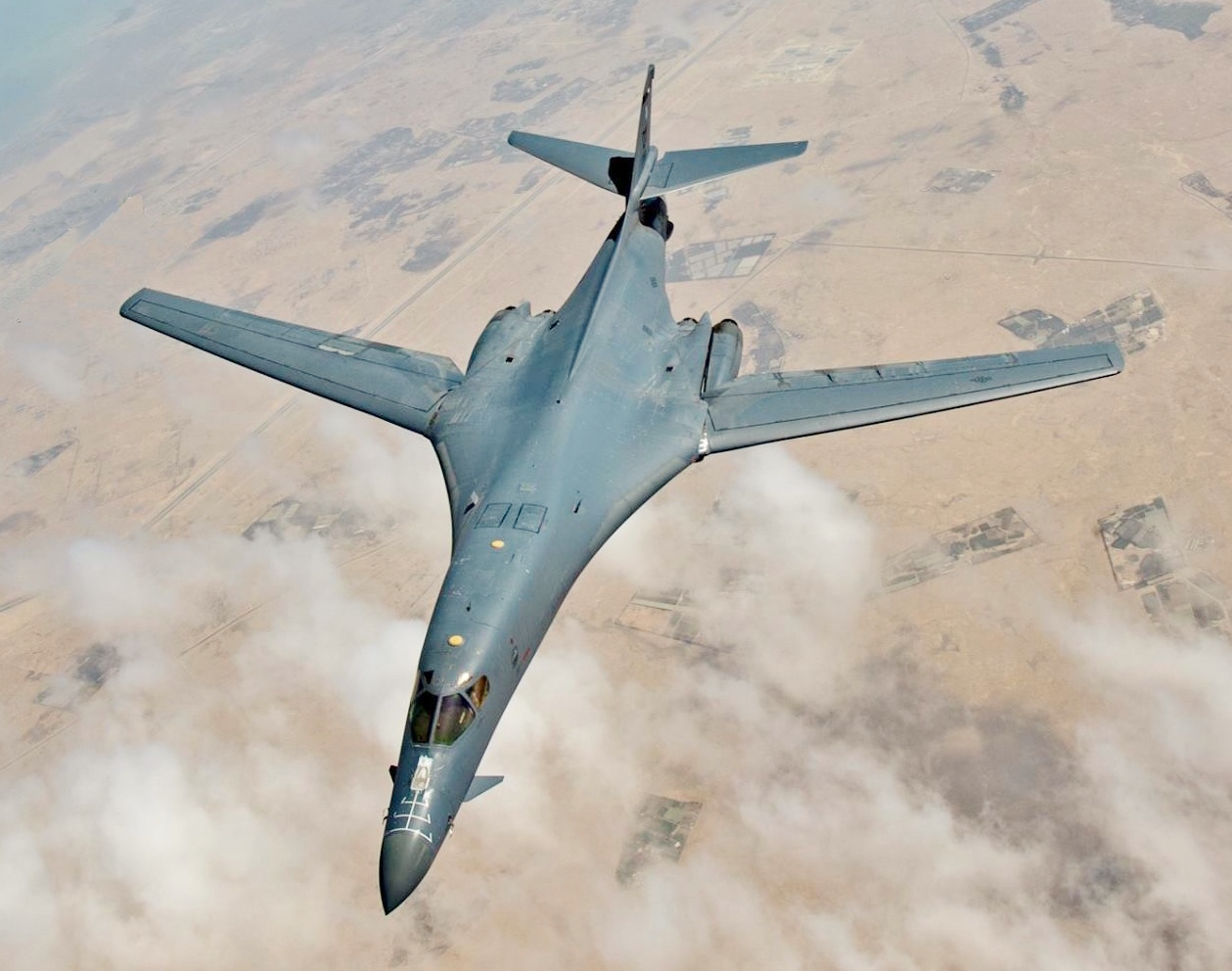|
Tu-16
The Tupolev Tu-16 (USAF/DOD reporting name Type 39; NATO reporting name: Badger) is a twin-engined jet strategic heavy bomber used by the Soviet Union. It has been flown for almost 70 years. While many aircraft in Soviet service were retired after the Cold War ended, the Chinese license-built version Xian H-6 remains in service with the People's Liberation Army Air Force, with the most modern variant, the H-6K, still being actively produced . Development In the late 1940s, the Soviet Union was strongly committed to matching the United States in strategic bombing capability. The Soviets' only long-range bomber at the time was Tupolev's Tu-4 "Bull", a reverse-engineered copy of the American B-29 Superfortress. The development of the notably powerful Mikulin AM-3 turbojet led to the possibility of a large, jet-powered bomber. The Tupolev design bureau began work on the Tu-88 ("Aircraft N") prototypes in 1950. The Tu-88 first flew on 27 April 1952. After winning a competitio ... [...More Info...] [...Related Items...] OR: [Wikipedia] [Google] [Baidu] |
Xi'an H-6
The Xi'an H-6 ( zh, c=轰-6, p=Hōng-6) is a twin-engine jet bomber of the Chinese People's Liberation Army Air Force (PLAAF). The H-6 is a license-built version of the Soviet Tupolev Tu-16 and remains the primary bomber aircraft of the People's Republic of China. Delivery of the Tu-16 to China began in 1958, and a license production agreement with the Soviets was signed in the late 1950s. By November 2020, the PLAAF had as many as 231, and continued to build the aircraft. The latest variant of the H-6 is the H-6N, a heavily redesigned version capable of aerial refueling and carrying air-launched cruise missiles. According to the United States Department of Defense, this will give the PLAAF a long-range standoff offensive air capability with precision-guided munitions. History Having entered service with the Soviet Union in April 1952, the Tupolev Tu-16 was one of the Soviets' earliest effective jet bombers, with over 1,500 produced through 1962. Early in 1956, the Soviet ... [...More Info...] [...Related Items...] OR: [Wikipedia] [Google] [Baidu] |
Strategic Bomber
A strategic bomber is a medium- to long-range Penetrator (aircraft), penetration bomber aircraft designed to drop large amounts of air-to-ground weaponry onto a distant target for the purposes of debilitating the enemy's capacity to wage war. Unlike tactical bombing, tactical bombers, Penetrator (aircraft), penetrators, fighter-bombers, and attack aircraft, which are used in air interdiction operations to attack enemy combatants and military equipment, strategic bombers are designed to fly into enemy territory to destroy strategic targets (e.g., infrastructure, logistics, Military base, military installations, factories, etc.). In addition to strategic bombing, strategic bombers can be used for tactical bombing, tactical missions. There are currently only three countries that operate strategic bombers: the United States, Russia and China. The modern strategic bomber role appeared after Strategic bombing during World War II, strategic bombing was widely employed, and Atomic bombing ... [...More Info...] [...Related Items...] OR: [Wikipedia] [Google] [Baidu] |
Soviet Air Force
The Soviet Air Forces (, VVS SSSR; literally "Military Air Forces of the Union of Soviet Socialist Republics"; initialism VVS, sometimes referred to as the "Red Air Force") were one of the air forces of the Soviet Union. The other was the Soviet Air Defence Forces. The Air Forces were formed from components of the Imperial Russian Air Service in 1917, and faced their greatest test during World War II. The groups were also involved in the Korean War, and dissolved along with the Soviet Union itself in 1991–92. Former Soviet Air Forces' assets were subsequently divided into several air forces of former Republics of the Soviet Union, Soviet republics, including the new Russian Air Force. The "Air March, March of the Pilots" was its marching song. Origins The first military aviation branch of Russia or any of the Soviet Union's constituent states was the short-lived Imperial Russian Air Service, founded in 1912 and disbanded in 1917 with the onset of the Bolshevik Revolution and ... [...More Info...] [...Related Items...] OR: [Wikipedia] [Google] [Baidu] |
Tupolev Tu-104
The Tupolev Tu-104 (NATO reporting name: Camel) is a medium-range, narrow-body, twin turbojet-powered Soviet airliner. It was the second to enter regular service, after the British de Havilland Comet and was the only jetliner operating in the world from 1956 to 1958, when the British jetliner was grounded due to safety concerns. In 1957, Czechoslovak Airlines – ČSA (now Czech Airlines), became the first airline in the world to fly a route exclusively with jet airliners, using the Tu-104A variant between Prague and Moscow. In civilian service, the Tu-104 carried over 90 million passengers with Aeroflot (then the world's largest airline), and a lesser number with ČSA, while it also was operated by the Soviet Air Force. Its successors included the Tu-124, Tu-134, and Tu-154. Design and development At the beginning of the 1950s, the Soviet Union's Aeroflot airline needed a modern airliner with better capacity and performance than the piston-engined aircraft then in opera ... [...More Info...] [...Related Items...] OR: [Wikipedia] [Google] [Baidu] |
Iraqi Air Force
The Iraqi Air Force (IQAF; ) is the aerial warfare service branch of the Iraqi Armed Forces. It is responsible for the defense of Iraqi airspace as well as the policing of its international borders. The IQAF also acts as a support force for the Iraqi Navy and the Iraqi Army, which allows Iraq to rapidly deploy its military. It is headquartered in Baghdad; the current commander is Lieutenant Gen. Shihab Jahid Ali. The Iraqi Air Force was founded in 1931, during the period of British control in Iraq after their defeat of the Ottomans in the First World War, with only a few pilots. The Iraqi Air Force operated mostly British aircraft until the 14 July Revolution in 1958, when the new Iraqi government began increased diplomatic relationships with the Soviet Union. The air force used both Soviet and British aircraft throughout the 1950s and 1960s. When Saddam Hussein came to power in 1979, the air force grew quickly when Iraq ordered more Soviet and French aircraft. The air forc ... [...More Info...] [...Related Items...] OR: [Wikipedia] [Google] [Baidu] |
Indonesian Air Force
The Indonesian Air Force (, sometimes shortened as IDAF / IdAF) is the Air force, aerial branch of the Indonesian National Armed Forces. The Indonesian Air Force is headquartered in Jakarta, Indonesia, and is headed by the Chief of Staff of the Indonesian Air Force, Chief of Staff of the Air Force ( – KSAU or KASAU). Its order of battle is split into three Air Operations Commands (). Most of its airbases are located on the island of Java. The Indonesian Air Force also has its ground force unit, called Air Force Quick Reaction Force Command (Kopasgat). The corps is also known as the "Orange Berets" () due to the distinctive color of their service headgear. The Indonesian Air Force has 30,100 personnel and equipped with 110 combat aircraft. The inventory includes 33 F-16 Fighting Falcons as the main fighters (from the United States) supplemented by five Su-27 and eleven Su-30 (from Russia), British Aerospace Hawk 200, Hawk 200, KAI T-50 Golden Eagle, KAI T-50 and Embraer EMB 31 ... [...More Info...] [...Related Items...] OR: [Wikipedia] [Google] [Baidu] |
Tupolev
Tupolev ( rus, Туполев, , ˈtupəlʲɪf), officially United Aircraft Company Tupolev - Public Joint Stock Company, is a Russian aerospace and Arms industry, defence company headquartered in Basmanny District, Moscow. UAC Tupolev is successor to the Soviet Tupolev Design Bureau (OKB-156, Soviet Union military aircraft designation systems#Soviet system after December 9.2C 1940, design office prefix ''Tu'') founded in 1922 by aerospace pioneer and engineer Andrei Tupolev, who led the company for 50 years until his death in 1972. Tupolev designed over 100 models of civilian and military aircraft and produced more than 18,000 aircraft for Russia, the Soviet Union and the Eastern Bloc since its founding, and celebrated its 100th anniversary on 22 October 2022. Tupolev is involved in numerous aerospace and defence sectors including development, manufacturing, and overhaul for both civil and military aerospace products such as aircraft and weapons systems, and also missile and nava ... [...More Info...] [...Related Items...] OR: [Wikipedia] [Google] [Baidu] |
Russian Air Force
The Russian Air Force () is a branch of the Russian Aerospace Forces, the latter being formed on 1 August 2015 with the merging of the Russian Air Force and the Russian Aerospace Defence Forces. After the dissolution of the Soviet Union, the reborn Russian armed forces began to be created on 7 May 1992 following Boris Yeltsin's creation of the Ministry of Defence (Russia), Ministry of Defence. However, the Russian Federation's air force can trace its lineage and traditions back to the Imperial Russian Air Service (1912–1917) and the Soviet Air Forces (1918–1991). History The Russian Air Force, officially established on 12 August 1912, as part of the Imperial Russian Air Service, has a long and complex history. It began as one of the earliest military aviation units globally, although its early years saw slow development due to the constraints of World War I. After the Russian Revolution, Russian Revolution of 1917, the air service was reorganised under the Soviet regime, ev ... [...More Info...] [...Related Items...] OR: [Wikipedia] [Google] [Baidu] |
Egyptian Air Force
The Egyptian Air Force (EAF) () is the aviation branch of the Egyptian Armed Forces that is responsible for all airborne defence missions and operates all military aircraft, including those used in support of the Egyptian Army, Egyptian Navy and the Egyptian Air Defense Forces. The latter was created as a separate command in the 1970s and it coordinates with the Air Force to integrate air and ground-based air defense operations. The EAF is headed by an air marshal (lieutenant general equivalent). Currently, the commander of the Egyptian Air Force is Air Marshal Mahmoud Fouad Abdel-Gawad. The force's motto is 'Higher and higher for the sake of glory' (, '). It was known as the Royal Egyptian Air Force until 18 June 1953 following the declaration of the Republic of Egypt by Muhammad Naguib. The Egyptian Army Air Service was formed in 1932, and became an independent air force in 1937. It had little involvement in the Second World War. From 1948 to 1973 it took part in four se ... [...More Info...] [...Related Items...] OR: [Wikipedia] [Google] [Baidu] |
Tupolev Tu-4
The Tupolev Tu-4 (; NATO reporting name: Bull) is a piston-engined Soviet Union, Soviet strategic bomber that served the Soviet Air Force from the late 1940s to the mid-1960s. The aircraft was a copy of the American Boeing B-29 Superfortress, having been Reverse engineering, reverse-engineered from seized aircraft that had made emergency landings in the USSR. Design and development Toward the end of World War II, the Soviet Union saw the need for a strategic bombing capability similar to that of the Western Allies. The Soviet VVS air arm had the locally designed Petlyakov Pe-8 four-engined "heavy" in service at the start of the war, but only 93 had been built by the end of the war and the type had become obsolete. The U.S. regularly conducted Air raids on Japan, bombing raids on Japan from distant Pacific forward bases using B-29 Superfortresses. Joseph Stalin ordered the development of a comparable bomber. The U.S. twice refused to supply the Soviet Union with B-29s under Lend ... [...More Info...] [...Related Items...] OR: [Wikipedia] [Google] [Baidu] |




